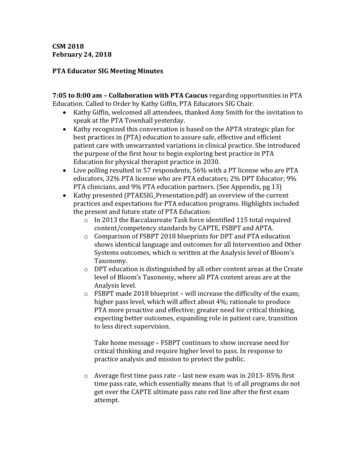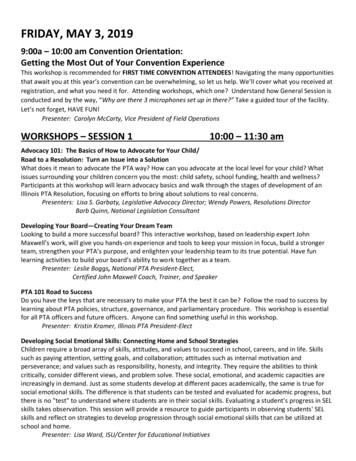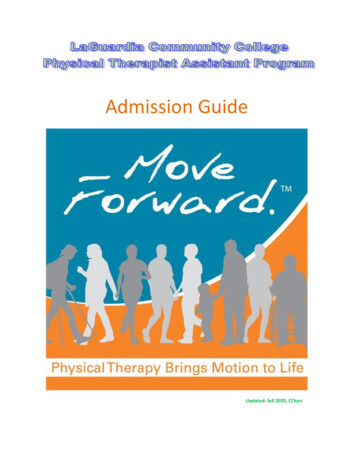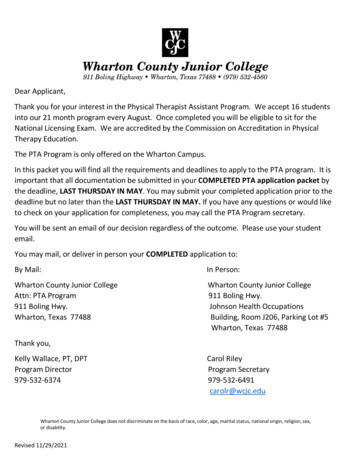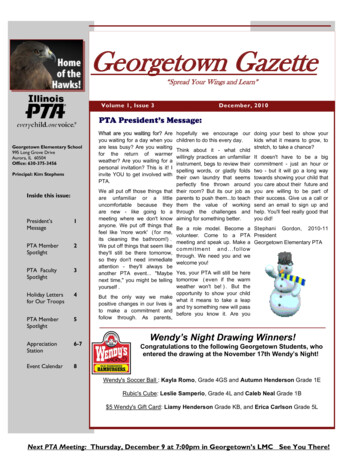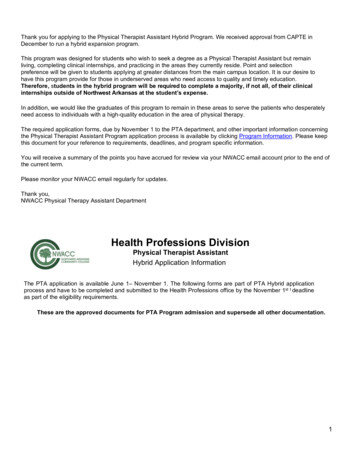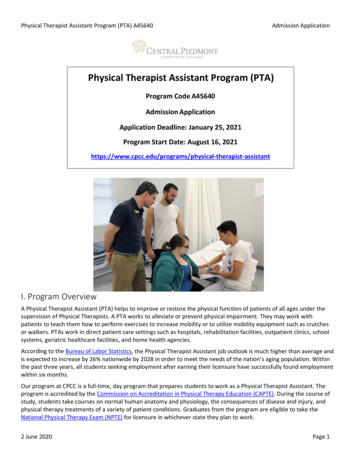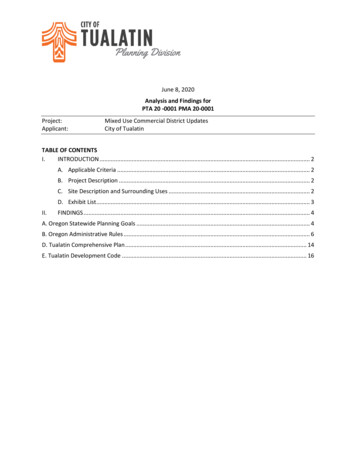
Transcription
June 8, 2020Analysis and Findings forPTA 20 -0001 PMA 20-0001Project:Applicant:Mixed Use Commercial District UpdatesCity of TualatinTABLE OF CONTENTSI.INTRODUCTION . 2A. Applicable Criteria . 2B. Project Description . 2C. Site Description and Surrounding Uses . 2D. Exhibit List . 3II.FINDINGS . 4A. Oregon Statewide Planning Goals . 4B. Oregon Administrative Rules . 6D. Tualatin Comprehensive Plan . 14E. Tualatin Development Code . 16
PTA & PMA 20-0001May 14, 2020Attachment DI.Page 2 of 22INTRODUCTIONA. Applicable CriteriaApplicable Statewide Planning Goals; Divisions 9 and 12 of the Oregon Administrative Rules; applicableGoals and Policies from the City of Tualatin Comprehensive Plan; applicable Sections of the City ofTualatin Development Code, including Section 33.070 (Plan Amendments).B. Project DescriptionThe City requests consideration of a Plan Text and Map Amendment (PTA 20-0001/PMA 20-0001) thatwould establish a Mixed Use Commercial District, which would be applied in the Durham Quarry Area,also known as the Bridgeport Village Area, which is currently subject to the provisions of the Mixed UseCommercial Overlay Zone (Chapter 57 of the Development Code). The updates also include a maximumbuilding height increase from 70 to 100 feet in a limited geographic area, further limited to mixed usecommercial/commercial lodging uses. The District would be applied to all lots eligible for the existingMUCOD designation. This area is located to the south and east of the boundary shared with Tigard, westof Interstate 5, and north of SW Lower Boones Ferry Road. The proposed amendments would facilitatedevelopment of vacant land and foster economic growth in the Bridgeport area.C. Site Description and Surrounding UsesSurrounding uses include a variety of commercial and residential uses:North:City of Tigard South:General Commercial (CG) West:SW Lower Boones Ferry RoadProvidence Medical Group- Center for Medical ImagingCity of Tigard East:Movie theaterBusiness ParksGeneral Commercial (CG) Trimet Park and RideInterstate 5
PTA & PMA 20-0001May 14, 2020Attachment DFigure 1: Aerial view of proposed map amendment areaD. Exhibit List1. Transportation Planning Rule (TPR) MemorandumPage 3 of 22
PTA & PMA 20-0001May 14, 2020Attachment DII.Page 4 of 22FINDINGSA. Oregon Statewide Planning GoalsGoal 1 – Citizen InvolvementTo develop a citizen involvement program that insures the opportunity for citizens to be involved inall phases of the planning process.Finding:The Tualatin Planning Commission held a public meeting on May 21, 2020, at which, an opportunity forpublic input was provided. The Planning Commission considered the proposed amendments, andforwarded a recommendation of approval of said amendments. The Planning Commission is an advisorybody to the City Council, which was created to satisfy Goal 1 Public Involvement requirements. TheTualatin City Council will hold a hearing on the proposed amendments on June 8, 2020, at which anadditional opportunity for public input will be provided. The proposed amendments conform to Goal 1.Goal 2 – Land Use PlanningTo establish a land use planning process and policy framework as a basis for all decision and actionsrelated to use of land and to assure an adequate factual base for such decisions and actions.[ ]Finding:The proposed amendments has been reviewed pursuant to the City’s established land use planningprocess and procedures, including its acknowledged Comprehensive Plan, and adopted DevelopmentCode. The proposed amendments conform to Goal 2.Goal 5 – Open Spaces, Scenic and Historic Area, and Natural ResourceFinding:Applicability of Goal 5 to post-acknowledgment plan amendments is governed by OAR 660- 023-0250.The proposed amendments do not modify the acknowledged Goal 5 resource list, or a policy thataddresses specific requirements of Goal 5. The proposed amendments do not allow uses that wouldconflict with a particular Goal 5 resource site on an acknowledged resource list. The proposedamendments conform to Goal 5.Goal 6 – Air, Water and Land Resources QualityFinding:The proposed Plan Amendments will establish a new Mixed Use Commercial District that will bringcompatible land uses closer together to make more efficient use of land and urban services. Permitteduses in the Mixed Use Commercial zone include housing, commercial, and offices uses. Development ofneeded housing close to jobs and services allows for reduced vehicle trips and greenhouse gasemissions. These changes will continue to preserve environmentally sensitive lands. The OregonDepartment of Environmental Quality (DEQ) regulates air, water and land with Clean Water Act (CWA)Section 401 Water Quality, Water Quality Certificate, State 303(d) listed waters, Hazardous Wastes,Clean Air Act (CAA), and Section 402 NPDES Construction and Stormwater Permits. The OregonDepartment of State Lands and the U.S. Army Corps of Engineers regulate jurisdictional wetlands and
PTA & PMA 20-0001May 14, 2020Attachment DPage 5 of 22CWA Section 404 water of the state and the country respectively. Clean Water Services (CWS)coordinates storm water management, water quality and stream enhancement projects throughout thecity. Future development will still need to comply with these state, national and regional regulations andprotections for air, water and land resources. The proposed amendments conform to Goal 6.Goal 7 – Areas Subject to Natural Disasters and HazardsFinding:The proposed amendments do not affect policies associated with Goal 7 established by theComprehensive Plan. Approval of the proposed amendments will not eliminate the requirement forfuture development to meet the requirements of the Chapters 70 and 72 of the Tualatin DevelopmentCode, which address development in hazard areas, such as the FEMA floodplain. The proposedamendments conform to Goal 7.Goal 9 – Economy of the StateTo provide adequate opportunities throughout the state for a variety of economic activities vital tothe health, welfare, and prosperity of Oregon's citizens.[ ]Finding:The proposed amendments would facilitate compact development with multiple compatible usescommonly found within main streets, downtowns, and neighborhood commercial centers which willfacilitate an increase in economic opportunities. The proposed amendments conform to Goal 9.Goal 10 – HousingFinding:The proposed amendments would add multifamily residential development (25 minimum dwelling unitsper acre) as a permitted use. This density is comparable to the High Density/High Rise (26-30 units anacre) district and will permit the greatest density in Tualatin. Additionally the amendments support thekey findings and goals of the Housing Needs Analysis that was adopted on December 9, 2019 which callsfor an additional 456 multi-family units (or 45% of supply) by 2040. Tualatin currently has a small deficitof land for higher density single-family and multifamily housing; therefore the proposed amendmentswill support and conform to Goal 10.Goal 11 – Public Facilities and ServicesFinding:Land within the City of Tualatin is adequately served by public facilitates and services. The amendmentsencourage compact development and efficient use of existing urban services and facilities, as analternative to extending new facilities. The proposed amendments conform to Goal 11.Goal 12 – TransportationTo provide and encourage a safe, convenient and economic transportation system.Finding:Goal 12 requires the provision and encouragement of a safe, convenient, multimodal and economictransportation system. The proposed amendments will foster compact, pedestrian oriented
PTA & PMA 20-0001May 14, 2020Attachment DPage 6 of 22development and are consistent with the City’s acknowledged policies and strategies for the provision oftransportation facilities and services as required by Goal 12 the Transportation Planning Rule (TPR), thefindings for which are found under Oregon Administrative Rules Chapter 660, Division 12. The proposedamendments conform to Goal 12.B. Oregon Administrative RulesOAR Chapter 660 Division 7 (Metropolitan Housing)[ ]660-007-0030New Construction Mix(1) Jurisdictions other than small developed cities must either designate sufficient buildable land toprovide the opportunity for at least 50 percent of new residential units to be attached single familyhousing or multiple family housing or justify an alternative percentage based on changingcircumstances. Factors to be considered in justifying an alternate percentage shall include, but neednot be limited to:(a) Metro forecasts of dwelling units by type;(b) Changes in household structure, size, or composition by age;(c) Changes in economic factors impacting demand for single family versus multiple family units; and(d) Changes in price ranges and rent levels relative to income levels.(2) The considerations listed in section (1) of this rule refer to county-level data within the UGB anddata on the specific jurisdiction.[ ]660-007-0035Minimum Residential Density Allocation for New ConstructionThe following standards shall apply to those jurisdictions which provide the opportunity for at least 50percent of new residential units to be attached single family housing or multiple family housing:[ ](2) Clackamas and Washington Counties, and the cities of Forest Grove, Gladstone, Milwaukie, OregonCity, Troutdale, Tualatin, West Linn and Wilsonville must provide for an overall density of eight ormore dwelling units per net buildable acre.[ ]Finding:The proposed amendments would add multifamily residential development (25 minimum dwellingunits per acre) as a permitted use. Tualatin’s 2019 HNA identified a deficit of capacity for about 101dwelling units of high density residential zoning, which the proposed amendments would help toaddress. Detached single-family residential is a prohibited use in the existing MUCOD and proposedMUC District. These criteria are met.OAR 660 Division 12 (Transportation Planning)[ ]660-012-0060Plan and Land Use Regulation Amendments(1) If an amendment to a functional plan, an acknowledged comprehensive plan, or a land useregulation (including a zoning map) would significantly affect an existing or planned transportationfacility, then the local government must put in place measures as provided in section (2) of this rule,
PTA & PMA 20-0001May 14, 2020Attachment DPage 7 of 22unless the amendment is allowed under section (3), (9) or (10) of this rule. A plan or land useregulation amendment significantly affects a transportation facility if it would:(a) Change the functional classification of an existing or planned transportation facility (exclusive ofcorrection of map errors in an adopted plan);(b) Change standards implementing a functional classification system; or(c) Result in any of the effects listed in paragraphs (A) through (C) of this subsection based onprojected conditions measured at the end of the planning period identified in the adopted TSP. Aspart of evaluating projected conditions, the amount of traffic projected to be generated within thearea of the amendment may be reduced if the amendment includes an enforceable, ongoingrequirement that would demonstrably limit traffic generation, including, but not limited to,transportation demand management. This reduction may diminish or completely eliminate thesignificant effect of the amendment.(A) Types or levels of travel or access that are inconsistent with the functional classification of anexisting or planned transportation facility;(B) Degrade the performance of an existing or planned transportation facility such that it would notmeet the performance standards identified in the TSP or comprehensive plan; or(C) Degrade the performance of an existing or planned transportation facility that is otherwiseprojected to not meet the performance standards identified in the TSP or comprehensive plan.(2) If a local government determines that there would be a significant effect, then the localgovernment must ensure that allowed land uses are consistent with the identified function, capacity,and performance standards of the facility measured at the end of the planning period identified in theadopted TSP through one or a combination of the remedies listed in (a) through (e) below, unless theamendment meets the balancing test in subsection (2)(e) of this section or qualifies for partialmitigation in section (11) of this rule. A local government using subsection (2)(e), section (3), section(10) or section (11) to approve an amendment recognizes that additional motor vehicle trafficcongestion may result and that other facility providers would not be expected to provide additionalcapacity for motor vehicles in response to this congestion.(a) Adopting measures that demonstrate allowed land uses are consistent with the planned function,capacity, and performance standards of the transportation facility.(b) Amending the TSP or comprehensive plan to provide transportation facilities, improvements orservices adequate to support the proposed land uses consistent with the requirements of thisdivision; such amendments shall include a funding plan or mechanism consistent with section (4) orinclude an amendment to the transportation finance plan so that the facility, improvement, or servicewill be provided by the end of the planning period.(c) Amending the TSP to modify the planned function, capacity or performance standards of thetransportation facility.(d) Providing other measures as a condition of development or through a development agreement orsimilar funding method, including, but not limited to, transportation system management measuresor minor transportation improvements. Local governments shall, as part of the amendment, specifywhen measures or improvements provided pursuant to this subsection will be provided.(e) Providing improvements that would benefit modes other than the significantly affected mode,improvements to facilities other than the significantly affected facility, or improvements at otherlocations, if:
PTA & PMA 20-0001May 14, 2020Attachment DPage 8 of 22(A) The provider of the significantly affected facility provides a written statement that the systemwide benefits are sufficient to balance the significant effect, even though the improvements wouldnot result in consistency for all performance standards;(B) The providers of facilities being improved at other locations provide written statements ofapproval; and(C) The local jurisdictions where facilities are being improved provide written statements of approval.(3) Notwithstanding sections (1) and (2) of this rule, a local government may approve an amendmentthat would significantly affect an existing transportation facility without assuring that the allowedland uses are consistent with the function, capacity and performance standards of the facility where:(a) In the absence of the amendment, planned transportation facilities, improvements and services asset forth in section (4) of this rule would not be adequate to achieve consistency with the identifiedfunction, capacity or performance standard for that facility by the end of the planning periodidentified in the adopted TSP;(b) Development resulting from the amendment will, at a minimum, mitigate the impacts of theamendment in a manner that avoids further degradation to the performance of the facility by thetime of the development through one or a combination of transportation improvements or measures;(c) The amendment does not involve property located in an interchange area as defined in paragraph(4)(d)(C); and(d) For affected state highways, ODOT provides a written statement that the proposed funding andtiming for the identified mitigation improvements or measures are, at a minimum, sufficient to avoidfurther degradation to the performance of the affected state highway. However, if a local governmentprovides the appropriate ODOT regional office with written notice of a proposed amendment in amanner that provides ODOT reasonable opportunity to submit a written statement into the record ofthe local government proceeding, and ODOT does not provide a written statement, then the localgovernment may proceed with applying subsections (a) through (c) of this section.(4) Determinations under sections (1)–(3) of this rule shall be coordinated with affectedtransportation facility and service providers and other affected local governments.(a) In determining whether an amendment has a significant effect on an existing or plannedtransportation facility under subsection (1)(c) of this rule, local governments shall rely on existingtransportation facilities and services and on the planned transportation facilities, improvements andservices set forth in subsections (b) and (c) below.(b) Outside of interstate interchange areas, the following are considered planned facilities,improvements and services:(A) Transportation facilities, improvements or services that are funded for construction orimplementation in the Statewide Transportation Improvement Program or a locally or regionallyadopted transportation improvement program or capital improvement plan or program of atransportation service provider.(B) Transportation facilities, improvements or services that are authorized in a local transportationsystem plan and for which a funding plan or mechanism is in place or approved. These include, but arenot limited to, transportation facilities, improvements or services for which: transportation systemsdevelopment charge revenues are being collected; a local improvement district or reimbursementdistrict has been established or will be established prior to development; a development agreementhas been adopted; or conditions of approval to fund the improvement have been adopted.
PTA & PMA 20-0001May 14, 2020Attachment DPage 9 of 22(C) Transportation facilities, improvements or services in a metropolitan planning organization (MPO)area that are part of the area's federally-approved, financially constrained regional transportationsystem plan.(D) Improvements to state highways that are included as planned improvements in a regional or localtransportation system plan or comprehensive plan when ODOT provides a written statement that theimprovements are reasonably likely to be provided by the end of the planning period.(E) Improvements to regional and local roads, streets or other transportation facilities or services thatare included as planned improvements in a regional or local transportation system plan orcomprehensive plan when the local government(s) or transportation service provider(s) responsiblefor the facility, improvement or service provides a written statement that the facility, improvement orservice is reasonably likely to be provided by the end of the planning period.(c) Within interstate interchange areas, the improvements included in (b)(A)–(C) are consideredplanned facilities, improvements and services, except where:(A) ODOT provides a written statement that the proposed funding and timing of mitigation measuresare sufficient to avoid a significant adverse impact on the Interstate Highway system, then localgovernments may also rely on the improvements identified in paragraphs (b)(D) and (E) of thissection; or(B) There is an adopted interchange area management plan, then local governments may also rely onthe improvements identified in that plan and which are also identified in paragraphs (b)(D) and (E) ofthis section.(d) As used in this section and section (3):(A) Planned interchange means new interchanges and relocation of existing interchanges that areauthorized in an adopted transportation system plan or comprehensive plan;(B) Interstate highway means Interstates 5, 82, 84, 105, 205 and 405; and(C) Interstate interchange area means:(i) Property within one-quarter mile of the ramp terminal intersection of an existing or plannedinterchange on an Interstate Highway; or(ii) The interchange area as defined in the Interchange Area Management Plan adopted as anamendment to the Oregon Highway Plan.(e) For purposes of this section, a written statement provided pursuant to paragraphs (b)(D), (b)(E) or(c)(A) provided by ODOT, a local government or transportation facility provider, as appropriate, shallbe conclusive in determining whether a transportation facility, improvement or service is a plannedtransportation facility, improvement or service. In the absence of a written statement, a localgovernment can only rely upon planned transportation facilities, improvements and servicesidentified in paragraphs (b)(A)–(C) to determine whether there is a significant effect that requiresapplication of the remedies in section (2).(5) The presence of a transportation facility or improvement shall not be a basis for an exception toallow residential, commercial, institutional or industrial development on rural lands under thisdivision or OAR 660-004-0022 and 660-004-0028.(6) In determining whether proposed land uses would affect or be consistent with plannedtransportation facilities as provided in sections (1) and (2), local governments shall give full credit forpotential reduction in vehicle trips for uses located in mixed-use, pedestrian-friendly centers, andneighborhoods as provided in subsections (a)–(d) below;(a) Absent adopted local standards or detailed information about the vehicle trip reduction benefits ofmixed-use, pedestrian-friendly development, local governments shall assume that uses located within
PTA & PMA 20-0001May 14, 2020Attachment DPage 10 of 22a mixed-use, pedestrian-friendly center, or neighborhood, will generate 10% fewer daily and peakhour trips than are specified in available published estimates, such as those provided by the Instituteof Transportation Engineers (ITE) Trip Generation Manual that do not specifically account for theeffects of mixed-use, pedestrian-friendly development. The 10% reduction allowed for by this sectionshall be available only if uses which rely solely on auto trips, such as gas stations, car washes, storagefacilities, and motels are prohibited;(b) Local governments shall use detailed or local information about the trip reduction benefits ofmixed-use, pedestrian-friendly development where such information is available and presented to thelocal government. Local governments may, based on such information, allow reductions greater thanthe 10% reduction required in subsection (a) above;(c) Where a local government assumes or estimates lower vehicle trip generation as provided insubsection (a) or (b) above, it shall assure through conditions of approval, site plans, or approvalstandards that subsequent development approvals support the development of a mixed-use,pedestrian-friendly center or neighborhood and provide for on-site bike and pedestrian connectivityand access to transit as provided for in OAR 660-012-0045(3) and (4). The provision of on-site bike andpedestrian connectivity and access to transit may be accomplished through application ofacknowledged ordinance provisions which comply with 660-012-0045(3) and (4) or through conditionsof approval or findings adopted with the plan amendment that assure compliance with these rulerequirements at the time of development approval; and(d) The purpose of this section is to provide an incentive for the designation and implementation ofpedestrian-friendly, mixed-use centers and neighborhoods by lowering the regulatory barriers to planamendments which accomplish this type of development. The actual trip reduction benefits of mixeduse, pedestrian-friendly development will vary from case to case and may be somewhat higher orlower than presumed pursuant to subsection (a) above. The Commission concludes that thisassumption is warranted given general information about the expected effects of mixed-use,pedestrian-friendly development and its intent to encourage changes to plans and developmentpatterns. Nothing in this section is intended to affect the application of provisions in local plans orordinances which provide for the calculation or assessment of systems development charges or inpreparing conformity determinations required under the federal Clean Air Act.(7) Amendments to acknowledged comprehensive plans and land use regulations which meet all ofthe criteria listed in subsections (a)–(c) below shall include an amendment to the comprehensive plan,transportation system plan the adoption of a local street plan, access management plan, future streetplan or other binding local transportation plan to provide for on-site alignment of streets oraccessways with existing and planned arterial, collector, and local streets surrounding the site asnecessary to implement the requirements in OAR 660-012-0020(2)(b) and 660-012-0045(3):(a) The plan or land use regulation amendment results in designation of two or more acres of land forcommercial use;(b) The local government has not adopted a TSP or local street plan which complies with OAR 660012-0020(2)(b) or, in the Portland Metropolitan Area, has not complied with Metro's requirement forstreet connectivity as contained in Title 6, Section 3 of the Urban Growth Management FunctionalPlan; and(c) The proposed amendment would significantly affect a transportation facility as provided in section(1).(8) A "mixed-use, pedestrian-friendly center or neighborhood" for the purposes of this rule, means:(a) Any one of the following:
PTA & PMA 20-0001May 14, 2020Attachment DPage 11 of 22(A) An existing central business district or downtown;(B) An area designated as a central city, regional center, town center or main street in the PortlandMetro 2040 Regional Growth Concept;(C) An area designated in an acknowledged comprehensive plan as a transit oriented development ora pedestrian district; or(D) An area designated as a special transportation area as provided for in the Oregon Highway Plan.(b) An area other than those listed in subsection (a) above which includes or is planned to include thefollowing characteristics:(A) A concentration of a variety of land uses in a well-defined area, including the following:(i) Medium to high density residential development (12 or more units per acre);(ii) Offices or office buildings;(iii) Retail stores and services;(iv) Restaurants; and(v) Public open space or private open space which is available for public use, such as a park or plaza.(B) Generally include civic or cultural uses;(C) A core commercial area where multi-story buildings are permitted;(D) Buildings and building entrances oriented to streets;(E) Street connections and crossings that make the center safe and conveniently accessible fromadjacent areas;(F) A network of streets and, where appropriate, accessways and major driveways that make itattractive and highly convenient for people to walk between uses within the center or neighborhood,including streets and major driveways within the center with wide sidewalks and other features,including pedestrian-oriented street crossings, street trees, pedestrian-scale lighting and on-streetparking;(G) One or more transit stops (in urban areas with fixed route transit service); and(H) Limit or do not allow low-intensity or land extensive uses, such as most industrial uses,automobile sales and services, and drive-through services.(9) Notwithstanding section (1) of this rule, a local government may find that an amendment to azoning map does not significantly affect an existing or planned transportation facility if all of thefollowing requirements are met.(a) The proposed zoning is consistent with the existing comprehensive plan map designation and theamendment does not change the comprehensive plan map;(b) The local government has an acknowledged TSP and the proposed zoning is consistent with theTSP; and(c) The area subject to the zoning map amendment was not exempted from this rule at the time of anurban growth boundary amendment as permitted in OAR 660-024-0020(1)(d), or the area wasexempted from this rule but the local government has a subsequently acknowledged TSP amendmentthat accounted for urbanization of the area.(10) Notwithstanding sections (1) and (2) of this rule, a local government may amend a functionalplan, a comprehensive plan or a land use regulation without applying performance standards relatedto motor vehicle traffic congestion (e.g. volume to capacity ratio or V/C), delay or travel time if theamendment meets the requirements of subsection (a) of this section. This section does not exempt aproposed amendment from other transportation performance standards or policies that may applyincluding, but not limited to, safety for all modes, network connectivity for all modes (e.g. sidewalks,
PTA & PMA 20-0001May 14, 2020Attachment DPage 12 of 22bicycle lanes) and accessibility for freight vehicles of a size and frequency required by thedevelopment.(a) A proposed amendmen
The City requests consideration of a Plan Text and Map Amendment (PTA 20-0001/PMA 20-0001) that would establish a Mixed Use Commercial District, which would be applied in the Durham Quarry Area, . To develop a citizen involvement program that insures the opportunity for citizens to be involved in all phases of the planning process.
